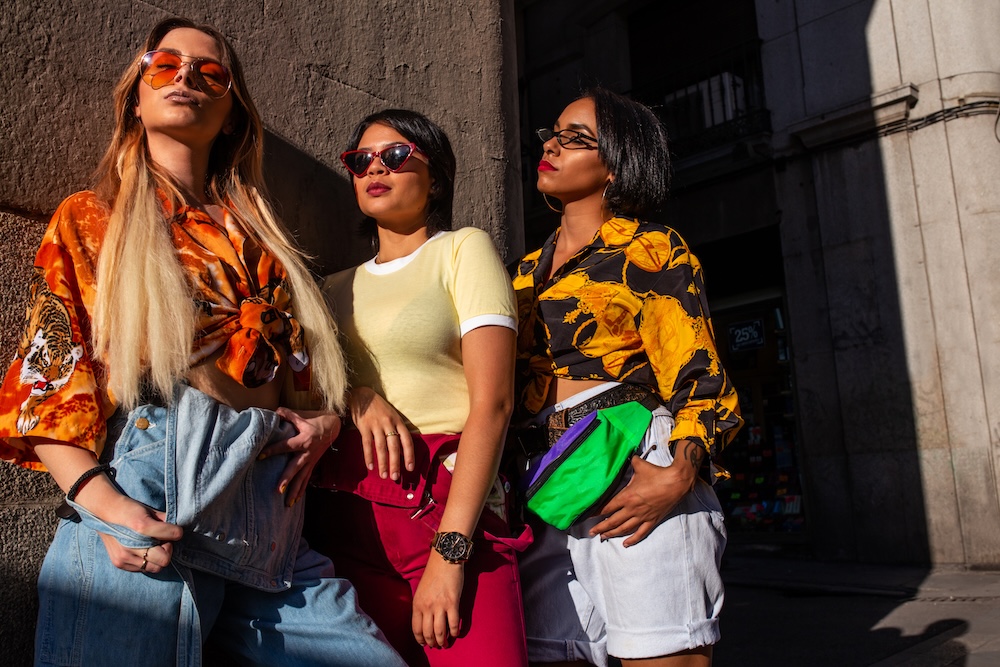The turn of the millennium was a moment filled with optimism, futurism, and cultural experimentation. It was the era of the “Y2K phenomenon,” a term that referred not only to the infamous computer bug but also to a bold aesthetic and style that defined late 1990s and early 2000s pop culture.
From holographic fabrics and velour tracksuits to sci-fi movie graphics and techno-inspired design, Y2K fashion and aesthetics captured a generation’s vision of the future. Today, this aesthetic is making a comeback — not just for nostalgia’s sake, but also as a way to revive and reimagine clothing in the era of sustainable fashion.
Y2K Fashion: Bold, Futuristic, and Playful
Y2K fashion was all about playful experimentation. Pop culture icons like Britney Spears, Destiny’s Child, and Jennifer Lopez helped bring crop tops, low-rise jeans, metallic fabrics, and platform shoes into the mainstream.
Key Y2K fashion staples included:
- Velour tracksuits (popularized by celebrities like Paris Hilton).
- Bright colors and holographics, evoking a futuristic vibe.
- Figure-hugging silhouettes, designed to celebrate bold self-expression.
- Chunky accessories and oversized sunglasses, completing the look.
While these pieces were often mass-produced during the fast fashion boom, their distinctive aesthetic has found a second life in the modern era through thrifting, resale apps, and vintage shops — making them a surprising ally in the shift toward a circular economy.
Y2K Aesthetic: Retro-Futurism Meets Digital Culture
Beyond fashion, the Y2K aesthetic stretched into design, art, and technology. It blended futuristic optimism with a touch of retro styling: pixel graphics, metallic finishes, and heavy references to the internet age.
This visual identity reflected the excitement of a digital future, with sci-fi films, video games, and early web design shaping everything from graphic design to interior trends. In hindsight, the Y2K aesthetic feels both nostalgic and eerily prophetic about our digital-first lifestyles today.
The Y2K Bug: A Digital Scare That Defined an Era
No discussion of Y2K is complete without the infamous “millennium bug.” Because many computer systems used two-digit dates, the year 2000 risked being read as “1900,” which raised fears of banking crashes, power outages, and mass system failures.
Governments and IT professionals worked tirelessly to fix code, and when midnight struck on January 1, 2000, disaster was largely avoided. In retrospect, the Y2K bug is remembered as much for the cultural panic it caused as for its technical implications.
Y2K Revival: Fashion Meets Sustainability
In recent years, Gen Z and Millennials have revived Y2K fashion on platforms like TikTok and Instagram. But this time, the revival is tied to sustainability. Instead of buying new, people are:
- Thrifting original pieces from the late ’90s and early 2000s.
- Repurposing and upcycling Y2K styles to create fresh looks.
- Supporting resale markets that keep clothing in circulation longer.
This resurgence shows how nostalgia-driven trends can actually support the circular fashion economy, encouraging consumers to value existing clothing rather than fueling demand for new fast fashion production.
Why Circular Fashion Matters in the Y2K Comeback
Fast fashion was accelerating rapidly during the original Y2K era, leading to overproduction, poor labor conditions, and massive textile waste. Today, re-embracing Y2K through sustainable practices offers a way to rewrite that story.
- Repair and reuse: Fixing or altering Y2K-era clothing keeps it functional and stylish.
- Resale and vintage markets: Selling and swapping keeps clothes in circulation and reduces waste.
- Repurposed materials: Old fabrics can be transformed into new items, supporting creativity and sustainability.
For brands, embracing this model isn’t just about sustainability — it’s also profitable. Repair programs, take-back initiatives, and resale platforms give businesses new revenue streams while aligning with consumer demand for eco-conscious fashion.
Final Thoughts
The Y2K phenomenon was more than just a bug or a fashion fad — it was a cultural snapshot of optimism at the dawn of a new millennium. Its fashion and aesthetics captured the tension between retro nostalgia and futuristic imagination.
Now, as Y2K makes a comeback, it highlights something even bigger: the potential of nostalgia-driven trends to support sustainable fashion. By thrifting, repurposing, and extending the life of Y2K-inspired pieces, we can embrace the fun and boldness of the era while building a more circular, sustainable future.
The past may be retro, but the way we wear it today can shape a better tomorrow.









Reader Interactions